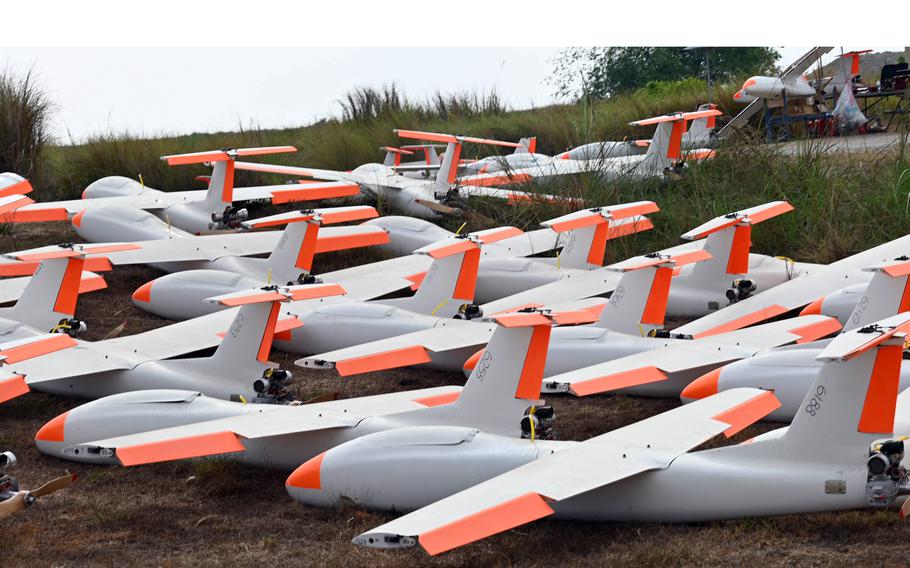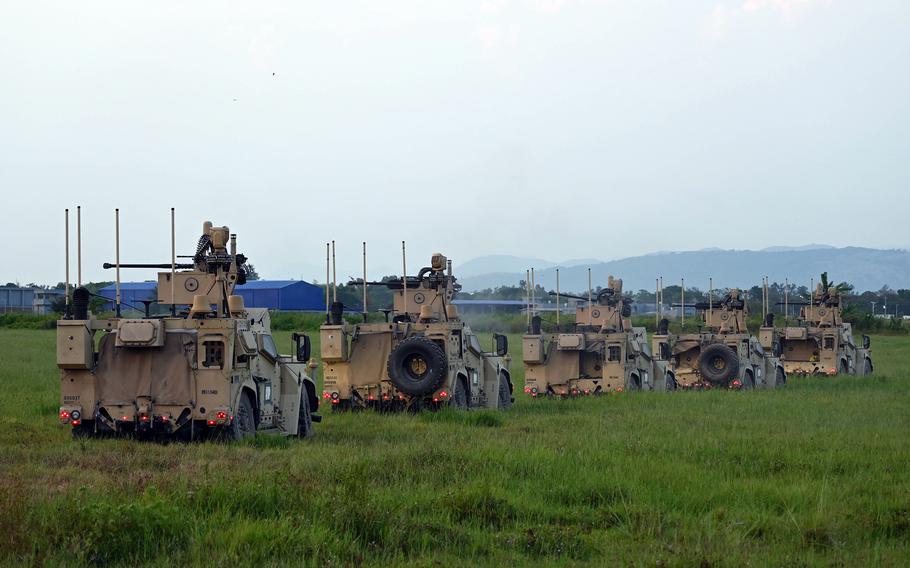
Members of the 3rd Marine Littoral Regiment watch the sun set near the South China Sea during a Balikatan drill at Naval Station Leovigildo Gantioqui, Philippines, April 25, 2025. (Seth Robson/Stars and Stripes)
SAN ANTONIO, Philippines — Tracer rounds flashed toward the setting sun Friday along the west coast of Luzon, the Philippines’ main island, as U.S. Marines put a new air-defense system through its paces.
The 3rd Marine Littoral Regiment recently fielded the Marine Air Defense Integrated System, or MADIS, and fired it for the first time in January at its home station in Hawaii.
They brought MADIS — equipped with Stinger missiles, a 30 mm cannon and 7.62 mm machine gun — on its first overseas trip for annual combat drills running through May 9 in the Philippines.

Members of the 3rd Marine Littoral Regiment supervise ammunition during a Balikatan drill at Naval Station Leovigildo Gantioqui, Philippines, April 25, 2025. (Seth Robson/Stars and Stripes)
The Balikatan exercise — Tagalog for “shoulder to shoulder” — brings together approximately 9,000 American and 5,000 Filipino troops for island-defense training.
MADIS is designed to defend against low-flying threats such as helicopters, planes and armed drones, which have proliferated in modern conflict zones in the Middle East and Ukraine.
Unmanned aircraft are expected to be no less of a threat should conflict break out over Taiwan or in the South China Sea, where Manila and Beijing have clashed repeatedly over disputed maritime territory.
During Friday’s live-fire drill, the regiment’s anti-air battalion deployed five light tactical vehicles mounted with MADIS at Naval Station Leovigildo Gantioqui, a coastal training area near Subic Bay.
Dozens of target drones were on hand to take flight, but the Marines focused their fire on ground-based targets along the coast.

Marine Corps target drones stand by for a Balikatan drill at Naval Station Leovigildo Gantioqui, Philippines, April 25, 2025. (Seth Robson/Stars and Stripes)
“These things have become prolific on the battlefield,” Col. John Lehane, commander of the littoral regiment, told Stars and Stripes before the drill began, referring to the drones.
The Iraq War veteran, who flies a hobby remote-control quadcopter in his free time, added: “We want to make sure we are proficient at taking them out.”
MADIS includes radar capable of detecting aircraft from 30 to 30,000 feet and at ranges of nearly 20 miles, according to the Missile Defense Advocacy Alliance, a Virginia-based group that lobbies for missile-defense development and deployment.
“The rapid rise of UAS (Unmanned Aerial Systems), used for surveillance, targeting and attacks, has made advanced air-defense systems like MADIS critical to protecting our Marines and preserving our combat effectiveness,” Lt. Col. Craig Warner, a future weapons systems manager at Marine Corps Systems Command, said in a Dec. 13 service news release.
“MADIS not only detects, tracks and defeats aerial threats but also serves as a powerful deterrent, signaling to adversaries that their aerial assets will not succeed against U.S. forces,” he added.

The 3rd Marine Littoral Regiment fields the Marine Air Defense Integrated System, or MADIS, at Naval Station Leovigildo Gantioqui, Philippines, April 25, 2025. (Seth Robson/Stars and Stripes)
The battalion’s tan tactical vehicles stood out against the lush tropical greenery of Luzon during the drill.
Humidity in the islands is affecting some of the vehicles, which were built for desert environments, Lt. Col. Matthew Sladek, the battalion’s commander, said at the training.
Future MADIS vehicles will be painted green and upgraded with new capabilities, he said, without divulging those details.
The regiment also brought another new weapon to the Philippines — the Navy-Marine Expeditionary Ship Interdiction System, or NMESIS.
Littoral Marines will train with the mobile system in northern Luzon and the Batanes Islands, Lehane said.
NMESIS fires naval strike missiles capable of hitting targets at ranges of about 115 miles. It includes launchers mounted on a 7-ton vehicle and two light tactical ones.

The 3rd Marine Littoral Regiment fields the Marine Air Defense Integrated System, or MADIS, at Naval Station Leovigildo Gantioqui, Philippines, April 25, 2025. (Seth Robson/Stars and Stripes)
The regiment acquired NMESIS in November. It plays a key role in the Marine Corps’ Force Design strategy, which envisions small units stationed at island choke points to deny adversaries access to contested seas.
Waterways separating northern Philippines from Taiwan — the Luzon Strait and Bashi Channel — are expected to play a strategic role in a Taiwan conflict.
China regularly deploys aircraft carriers and escorts through the Bashi Channel to the seas off Taiwan’s eastern coast and flies military aircraft over the area.
“If you can control choke points, you can control the commerce that goes through them,” Lehane said.